September 26th, 2007
US version, $79.95
Hardbound, 10 1/4 x 10 1/4 inches , 208 pages,
All color photography
Published by Veloce Publishing LTD, 33 Trinity Street, Dorchester, Dorset DT1 1TT, England
Telephone 01305 260068
ISBN: 978-1-84584-132-4/UPC
Order from Veloce Publishing
From the early 1980s to the mid 1990s, Lancia, already owned by Fiat, virtually dominated the World Rally Championship with a small, unobtrusive looking tintop called the Delta.
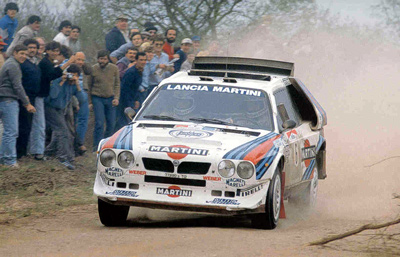
The S4 hard at work. The mid engined car can be spotted by the large rear air intakes over the rear wheels.
|
Enthusiasts in the United States heard little of it. Since neither Fiat nor Lancia were being sold in the U.S.,
there was little reason for car magazines to publicize the new Delta, which although was not a looker, was voted European Car of The Year in 1980. Since the World Rally Championship rarely held events in the U.S., there was little if any coverage of that scene by U.S. magazines either. No longer driven by ad dollars from Lancia, Fiat, Alfa and Abarth, the U.S. automotive media acted as if Italy had fallen off the map.
�To judge this book by the layout (which is busy but not bad) would be to misjudge a very good book indeed.
Nevertheless, the Italians were joyously going about their business, and the business of Lancia was wining rallies. From 1987 to 1992, variations of the innocuous Lancia Delta won the World Rally Manufacturers Championship and unprecedented and still unbeaten six times in a row.
That little Lancia Delta must have been some car.
To honor the Delta�s significant achievements, German Lancia enthusiast Walter Blaettel teamed up with Fiat/Lancia photographer Gerhard D. Wagner to produce a book worthy of the Delta�s successes. �Lancia Delta HF Integrale: The story of a champion", was originally published in Germany and this year published in English by Veloce Publishing Limited, superbly translated by Peter L. Albrecht.
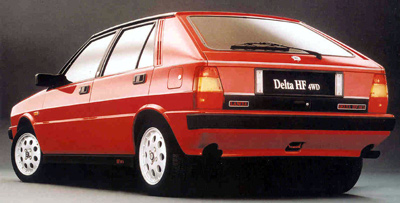
Back to production based rally cars in 1986, Lancia made the Delta with 4WD and it too was a success.
|
Paging quickly through the book�s 208 pages, as one might do in a bookstore, the Blaettel/ Wagner effort comes off as a confusing mix of text and color, with headings and fonts and images strewn before one�s eyes with no apparent rhyme. But to judge this book by the layout (which is busy but not bad) would be to misjudge a very good book indeed.
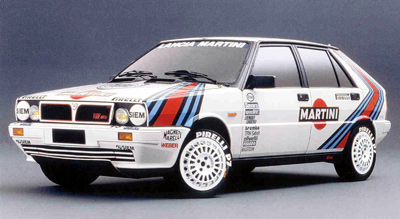
This is the works rally version of the HF 4WD which won nine World Rally events in 1987.
|
For us, the Delta was fresh meat. We wanted to learn all about this car from the ground up and in a fashion which was not only a good read but organized in a comprehensive and logical manner. As the initial take was somewhat disappointing, we wondered if the German penchant for organization and detail would soon be revealed. We were soon pleased. The table of contents took the subject from the Lancia High Fidelity story to a short but useable index.
�That little Lancia Delta must have been some car��
The meat of the book was also well organized. A chapter on the pacesetting Delta S4 Stradale, (a monster Delta derivative created for the ill fated and fatal Group B rally cars of 1985) was followed by the Delta HF 4WD of 1986-87, the HF Integrale of 1987-1989, the HF Integrale 16V, 1989-91, and the Evo 1, last real rally car from Lancia.
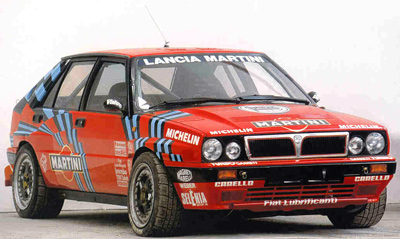
Martini Rossi in red, a one time paint job for the Integrale 16V.
|
Within each of these chapters are complete technical descriptions of both the production cars and the rally cars, and an overview of the relevant rally season. We are able to quickly determine the modifications of each model from the standard fare, the improvements and gains, followed by the successes achieved.
With each chapter, Wagner�s excellent photographs fall right into place, documenting the development and rally wins of the Deltas and no longer look disorganized. One�s perception of the book is transformed by critical inspection.
Blaettel, the President of the German Lancia Delta HF Integrale Club, goes further than just to describe the Delta rally cars. There were a number of limited production and special editions produced by the factory, and a chapter is devoted to those cars (and how to spot them). Another chapter describes the prototypes and special editions made other than by the factory. Yet another full chapter is reserved for the Lancia Hyena by Zagato, probably the most costly and most desirable of all the Delta HF cars.
This cornucopia of information is followed by a short chapter on accessories and collectable associated with the Delta, remembrances of Ninni Rosso and driver Juha Kankkunen, and a list of Lancia�s motorsports records, which begins with the 1972 World Championship Rally season and follows through to the 1999 season when privateers were still entering Delta Evos. And for the records, Lancia won the Manufacturer�s Championship in 1972, 1974-76, with the Fulvia and Stratos, 1983 with the Rally 037, 1987-1992 with variations of the Delta HF.
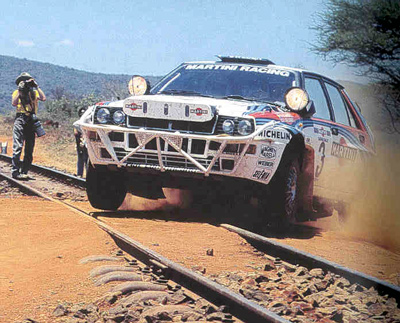
The Evo 1, last of the breed, seen here at the Acropolis Rally in 1992.
|
VeloceToday already has a book review on the
Lancia Stratos. Elsewhere in this edition of VeloceToday
are Hugh Doran's articles on the Lancia 037 and the Delta HF.
All of these cars were built at the Abarth factory at Corso Marche 40 in Turin, under the management of Cesare Fiorio. But in 1992, Abarth was dissolved, Lancia�s racing program suspended, and the creative and successful era which flourished at Corso Marche came to an end. The Lancia Abarth Martini Rossi team bridged the distance between the less formal, low tech, racing teams of the past and the brutal, highly sophisticated, uptight and expensive racing teams of today�s motorsports.
Cars like the Lancia Delta HF, with such a successful competition history are much sought after, and to track them down means getting on with the telaio, or chassis number game. And unfortunately for historians of the more modern classics, of which these special Lancias most surely are, the task is often no easier for a factory entered 1990 Lancia Delta HF Integrale 16V than a pre war Alfa. Working from registration numbers, chassis numbers have been identified in many instances and the author provides an overview the competition history of Group A works and semi works cars from 1987 to 1993. It�s a work in progress but already significant in size and detail. For the true Delta HF nut, this section of the book alone makes the $79.95 price well worthwhile.
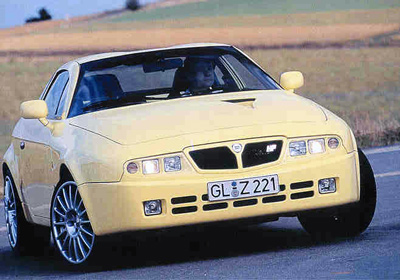
Zagato's Hyena, based on the Integrale. Only twenty four were made.
|
It is also a good read. As we all know, very few automotive books are page turners, but Blaettel�s prose as translated by Albrecht is interesting enough to keep the midnight oil burning. Blaettel�s enthusiasm and knowledge transcends the language gap. The decade of the 1980s witnessed a tremendous surge in improved technology; four wheel drive, turbo charging (the Delta S4 had both a turbo and a supercharger), breathing (efficient four and five valves per cylinder, fuel injection) braking (ABS) and computerized engine control functions and each new technology was immediately incorporated into the Delta Rally program. Describing these vast changes in technology is handled well by the author and translator. Of course there are questions left unanswered, never asked in the first place, and at times more technical diagrams and information would have been nice (particularly in regards to the mid engined Delta S4). But it�s a pretty thorough book for the amount of material covered.
Although we have forgone our old ratings system, �Lancia Delta HF Integrale� would easily rate four stars.
|



